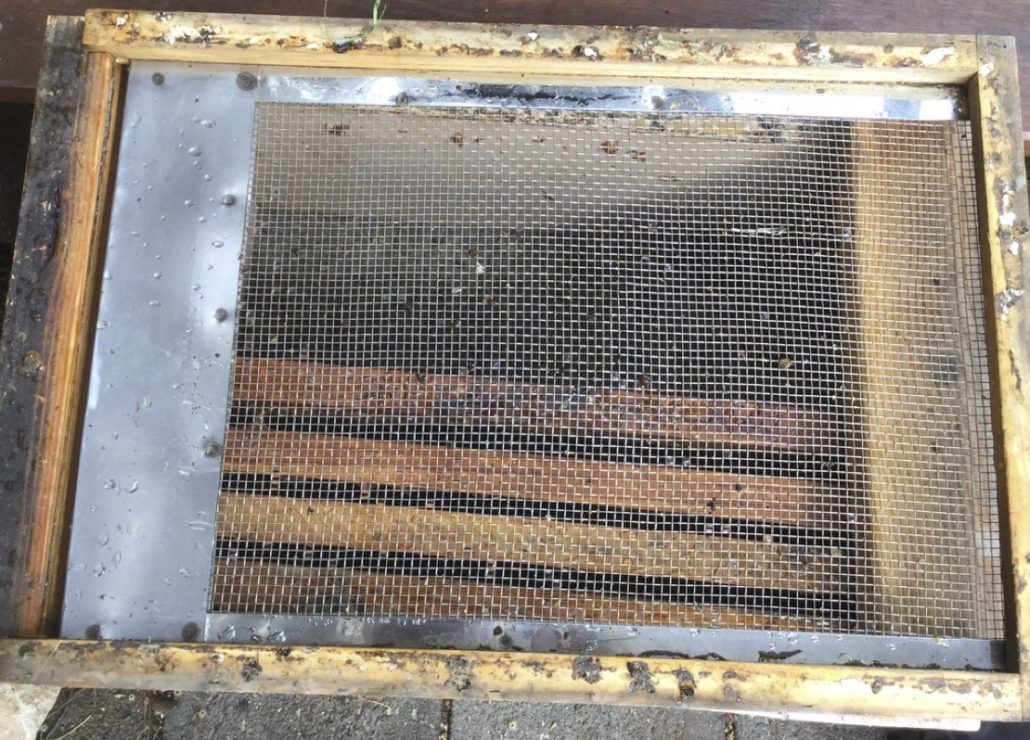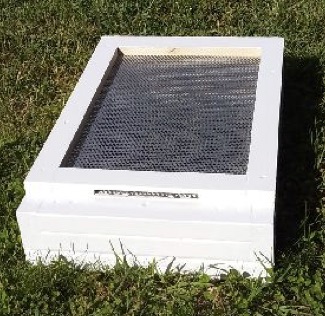Bee Buzz Box
Bees in Summer
February 2019
Alan Wade
Bounteous summer is the season bees have to have. However Australian summer heatwaves would seem rather too cooky for our bees as these insects evolved in European climes. Employing African and Middle Eastern races would seem, from a bee perspective, a better match to Australian conditions. For the apiarist this notion has long been abandoned as their inclination to remain aggressive, to abscond and to swarm are only too well known.
So while European honey bees are well adapted to surviving deep winters and mild summers, the extremes of Australian summers – year round in the tropics – are pretty rough on bees:
G’day G’day. Beg your pardon,
I am here to wreck your garden:
Tongue is cracked, claws are hot.
I’ve got prickles in my bot.
On my back some nasty fires
Caused by snapped electric wires:
Eyes like newly broken bottles,
Lips are dead and twisted wattles:
I breathe blow flies – what a bummer.
Hey? G’day, I am summer!
Michael Leunig
A tough antipodean climate is not the only challenge
That Australian conditions can be challenging for bees is not just because of the extremes of climate or seasonal factors. Colonies working leatherwood (Eucryphia lucida) flows in Tasmania are renowned for supersedure, that is colony self queen replacement. Yellow Box (Eucalyptus mellifera) and Mugga Ironbark (Eucalyptus sideroxylon) flows, in the absence of a reliable pollen source, place honey bees under tremendous nutritional stress. Come back in late summer at the end of a yellow box flow or in spring as ironbark flowering is finishing up and you may find hives full of honey but with virtually no bees. Toss in an outbreak of EFB or chalkbrood – stress enhanced diseases – and your apiary will be cactus.
In a recent two-week ‘dry season’ trip to Darwin I saw plenty of native bess (Tetragonula millipes) but not a single honey bee. The reason: there were virtually no flowering plants.
But let us turn to the more insidious effect of hot weather on bees. What to do about hives sitting out in the blazing sun or about the recognition that bees heading out to squirrel away winter stores will be scorched by hot searing winds? But first let us look at the impact of really hot weather on the internal workings of the hive and what else we might do to ameliorate the effects of too much sunshine.
The intrinsic hive condition
Without some relief, weak hives or bees without good access to water stop working and can melt down on the hottest days. Strong hives will beard from the front of hives to reduce crowing and permit more effective air circulation.
Good internal hive protection strategies available include a mix of good hive insulation, a screened bottom board to allow the bees to turn on their air conditioning and ready access to water. With poorly insulated plastic and wooden Langstroth boxes, I am not well-placed to alleviate that thermal stress. That said, I have changed over to screened bottom boards and I’m looking at the options for insulating migratory lids, that is without creating a refuge for Small Hive Beetle and Wax Moth.
Hive shading
While some shading of hives may be advisable on the hottest of summer days, many amateurs are surprised to see that commercial operators locate their bees in full sun in roadside paddocks. With the prospect of a poor flow, those same beekeepers will often as not move their bees to cooler high country. This strategy avoids the prospect of wearing bees out for little or no gain.

Morning sun year round and dappled summer midday and afternoon shade in my very heavily treed and vegetable dominated garden
Placing your bees under a lean-to shelter or in heavy shade, however, is a recipe for disaster. Damp and shade especially promote Nosema disease. Short of dappled summer shade, always locate your bees in full sun. Since backyard bees are rarely moved, find a sunny warm spot in the veggie patch or on a north facing wall and keep them well clear of shady dells.
Hot dry conditions may be good for honey ripening and evaporative cooling but are not much chop for brood were it not for hard working water harvesting and fanning nurse bees. However well intentioned, efforts made to protect hives from the sun are a mistake. Wind protection and locating bees in a clearing or in a sunny location behind a hedge are more practical measures to minimise colony stress.
Siting your bees well, where they won’t be a nuisance and more critically to always get sunshine if not too much, is one of the most critical decisions you need to make if you expect to get honey and not lose your bees to disease.
Hive insulation
In the June 2018 edition of Bee Buzz Box we explored the condition of Bees in Winter. There we explored the value of insulation referring to Mitchel’s study of the protective thermal barriers afforded to colonies located deep in a tree hollow. What Mitchell found was that really good insulation allows bees to easily regulate their internal thermal, relative humidity and air circulation environment essential to colony homeostasis.
Observations of new-fangled high density polystyrene hives have shown that in both spring and autumn bees fly earlier and later and that bees fly better during the day in really hot weather. While wrapping of high latitude northern hemisphere beehives has been long recognised as important for the survival of bees under snow, hive insulation under almost all conditions has now emerged as truly important for optimal performance of honey bees.
Screened bottom boards
Paradoxically open screened bottom boards allow bees to control the internal environment of the hive even under extreme conditions. This has led to the club to swapping out old-fashioned solid bottom boards with fully open screened boards (see Readings), something I’ve also done at home over the past couple of years.
With the proviso that hives get some wind protection, screened bottom boards allow bees to fully regulate both relative humidity and nest temperature. Screened bottom boards are also self cleaning: insect fras and diseased material fall, so to speak, through the cracks. This removes hive debris, a fertile breeding ground for wax moth and small hive beetle, and diseased material such as chalkbrood mummies.


Commercial screen (left) and just as good Hawke model (right)
Screened bottom boards are way over-priced but the clubs’ stores manager Ian Hawke has been knocking them up at home for $10, the cost of good quality wire screening. Otherwise pals have been modifying old bottom boards, cutting out the floor and installing screen mesh.
Water provisioning
There are anecdotal stories of bees flying as far as 20 km to water in desert environments, so water close at hand, the farm dam or the backyard pond, is one strategy for minimising colony stress.
You will find stacks of recommendations to provide water for your bees, not least from club members. Proffered advice is often to encourage beekeepers to supply pans of water with floating straw or to drip water onto hessian, systems that quickly fall into disrepair. Well maintained ponds with floating vegetation are a better prospect. Here is an attractive garden feature, a large shallow lightweight fibre-cement pot with native Marsilea (Nardoo).

My bees visit several of these pots on hot days rather
than downing in the neighbours’ swimming pools.
Opening hives
When, how and for how long to open hives is the subject of perennial and, so to speak, heated or chilling, debate. When common sense finally prevails it is clear that regular inspections are essential for both surveillance of colony condition and for good hive management.
Opening hives always disrupts the social ordering of the colony, an effect that may linger from hours to days. Severe and frequent disruption of hives, especially under excessively hot, cold or windy conditions, can have long term impact especially in promoting stress diseases.
In strong healthy colonies brood nest humidity ranges between 50% and 60% while the temperature is maintained between 32 0C and a more ideal 35 0C. The direct impact of opening hives is twofold:
-
under very hot and windy conditions, the principal risk is that of desiccation of brood; and
-
the more frequently instanced effect of opening hives is that of brood chilling, that is when ambient temperatures fall below around 16-18 0C.
In either instance keeping hives open for too long and unnecessarily exposing brood frames risks killing brood.
In commercial beekeeping practice bees are routinely worked under almost all conditions though the guiding principle is to minimise the time a hive is kept open. There is nothing wrong with filling a top feeder or removing a honey crop at any time especially if the brood nest is not disturbed and bees are not robbing. For the amateur and seasoned beekeeper, choosing mild conditions – rather than total fire ban days – will be kinder to bees and beekeeper alike.
The extrinsic environmental condition
Old bees, near their use by date, are fairly expendable and in the mature hive undertake all the foraging. However excessive mortality associated with extreme weather conditions can and does effect the honey gathering potential of the hive.
Bee forager conditions
For field bees, the optimal ambient foraging temperature is in the range 20 – 25 0C. Bees can actually operate up to 50 0C, but then only for very short periods. Can we change this equation? Not really!
It would seem that there is no way – short of changing climate policy – to influence the external operating environment for bees at any time of the year. Bees typically forage up to 5 km from the nest – perhaps as far as 8 km when flowering resources are scarce.
Think πr2,, or a football field where centre boots a ball to the boundary. The potential foraging area in question is pretty big, roughly 3 x 5 x 5 square kilometres, that is at least 75 sq km. Toss in the fact that insects have a high surface area to body mass ratio and its no wonder that hot dry windy conditions will take severe toll on bees.
This culling effect is illustrated by the similar impact that diseases such as Nosema – another stressor – inflicts on honeybees. Often enough bees may reach a rich flowering source only to be succumb and die in the thousands at that Holy Grail. Under hot windy conditions a similarly disproportionate number of field bees simply do not make the trip home.
Safe haven
Giving the bees safe haven in a wind-sheltered and well-insulated hive will go far to improve the performance of your bees. So too, will well nourished bees and a productive young queen. So while field bee mortality can be extremely high there is much you can do to give your bees their best shot.
If you are at the beach, reflect on the fact that lying out in the sun and nursing sunburn later is much akin to the bee risking its life to collect liquid sunshine, honey.
Readings
Mitchell, D. (2016). Ratios of colony mass to thermal conductance of tree and manmade nest enclosures of Apis mellifera: implications for survival, clustering, humidity regulation and Varroa destructor. International Journal of Biometereology 60: 629-638. https://docs.google.com/viewer?a=v&pid=forums&srcid=MTQ1OTYwMzIwNzQ2NzIzNDE4MDcBMDc3NDA4MjkyOTA0MTMzNTYzMDUBUjE0WWxzVU9BZ0FKATAuMS4xAQF2Mg
Somerville, D. (2014). Rural Industries Research and Development Corporation (August 2014). Screened bottom boards. RIRDC Publication N). 14-061. https://www.agrifutures.com.au/wp-content/uploads/publications/14-061.pdf

Be the first to comment